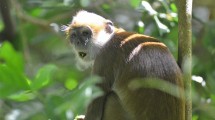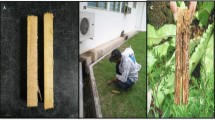Abstract
Rodents of the family Heteromyidae are proficient gatherers and hoarders of seeds. A major component of their adaptive specialization for harvesting and transporting seeds is their spacious, fur-lined cheek pouches. Precise measurements of cheek pouch capacities are essential if ecologists are to understand the foraging ecology, possible constraints on locomotion patterns, and competitive relationships of heteromyid rodents. To measure the size of these cheek pouches and the rate at which animals load seeds into their pouches during seed harvest, we attracted 56 individuals representing ten species of heteromyid rodents to bait stations in the field and allowed them to fill their cheek pouches with seeds several times while we observed and timed the events with the aid of night-vision equipment. The largest load taken by each individual was used as an estimate of its cheek pouch capacity. At the end of observations, each subject was captured and its mass and other data gathered. The allometric relationship between cheek pouch capacity and body mass for ten species of heteromyids was significant [pouch capacity (ml) = 0.148 body mass (g)0.992, r 2=0.91, P<0.0001]. The regression coefficient is ≈1.0, which indicates that the volume of the cheek pouches scales in direct proportion to body size. When the data were subdivided into quadrupeds (Perognathus and Chaetodipus) and bipeds (Dipodomys) (n=5 for each), the relationships between pouch capacity and body mass were significant, but the two regressions were not significantly different from each other. When all loads (full and partial) were considered, subjects filled their cheek pouches an average of 93 ± 10% of pouch capacity (n=185). Cheek pouch capacities from published studies of artificially filled pouches of heteromyids in the laboratory averaged about 40% below the field measurements obtained here. The allometric relationship between mean loading rate and body mass was also significant [seeds/s=1.067 bodymass (g)0.830, r 2=0.85,P=0.0011), but when quadrupeds and bipeds were considered separately, the relationships were not significant. Seed densities and bulk densities were used to calculate packing coefficients for seed species, which, when used in conjunction with the allometric relationship between cheek pouch capacity and body size, can be used to estimate the maximum load carried by a heteromyid. Except for the very largest kangaroo rat species, a full pouch load of Indian ricegrass seeds represents less than the daily energy requirements of an active heteromyid.
Similar content being viewed by others
Author information
Authors and Affiliations
Additional information
Received: 3 March 1997 / Accepted: 15 July 1997
Rights and permissions
About this article
Cite this article
Vander Wall, S., Longland, W., Pyare, S. et al. Cheek pouch capacities and loading rates of heteromyid rodents. Oecologia 113, 21–28 (1997). https://doi.org/10.1007/s004420050349
Issue Date:
DOI: https://doi.org/10.1007/s004420050349




